Truth, Lies and Hungry Rock
The mind boggles at the outright lies that people will tell in support of their theories, whether conspiracy theories about voter fraud and Covid-19 vaccinations, or others with theories about pyramid building, Noah's ark or chariot wheels in the Red Sea. In preparation for this article I typed "hungry rock aswan" into a search engine and was presented with several web pages. The first was a Wikipedia article giving a good deal of factual information.
The second was an article that made no mention whatsoever of "hungry" or "famine", but did include the words "rock" and "aswan". It also blathered on about how the ancient Egyptians used "sophisticated technology" and claims that there is evidence for this at the quarries in Aswan. There isn't - but there is plenty of evidence of standard stone-quarrying techniques well within the capabilities of ancient Egypt, such as the "wedge and feathers" for splitting stone.
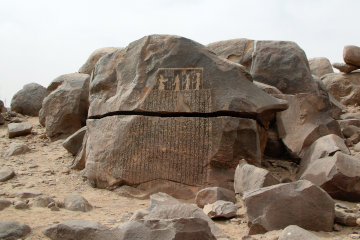
| |
| A general view of Hungry Rock on Sahel Island. |
The third is a site that appears to be devoted to everything kooky and the particular page referenced by the search engine claims that the ancients were able to soften stone by chemical means and then pour and mould them into place in the buildings they constructed. It has a photograph of Hungry Rock, beneath which it states, "The Famine Stele or Hungry Rock; its hieroglyphs describe in detail the technique for stone softening. The god Jnum passed this information to Zoser, second Pharaoh of the Third Dynasty."
The god referenced by the Famine Stele is Khnum, not Jnum, and the hieroglyphic inscriptions says nothing whatsoever about softening stone. You can read a translation of the inscription on this website.
There are several lacunae in the translation, marked in the usual way with ellipses ("...") and these correspond to the missing bits of stone that have broken off by natural weathering. You can see several such places where stone has broken off in any photograph of the inscription.
The famous Famine Stele is situated on Sahel island (also spelled Sehel or Seheil), approximately two miles south of Elephantine Island. The only time I have been there was with a Diggings group and we hired a falucca outside our hotel (the New Cataract Hotel) and sailed the whole way upstream. I understand, however, that you can take a taxi to the river bank opposite the island and then catch the little boat which rejoices in the title of "ferry" across the river to the island. This will be the quickest and cheapest way if you are travelling on your own.
At the landing stage you will almost certainly be greeted by a mob of children eager to act as guides to "Hungry Rock" - no need to worry about Arabic names! If you have never been there before, you would be well advised to hire one of these children, as the Famine Stele is not all that easy to find.
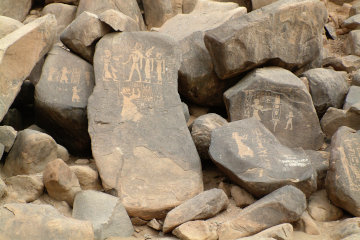
| |
| Votive inscriptions on Sahel Island |
Basically, you walk along the shore of the river until you reach a prominent rocky hill at the southern tip of the island. The hill is made up of lumps and boulders of granite which are stained a dark brown by the patina which has built up over thousands of years. However if you have considerable reserves of patience, you could use a small piece of granite to rub or chip at this patina and expose the lighter coloured rock beneath.
And, in fact, this is what considerable numbers of the ancient Egyptians did (or paid someone else to do). All around the base of the hill - and indeed, on various outcrops elsewhere on the island - there are hieroglyphic inscriptions, often accompanied by representations of various gods. Diligent Egyptologists have copied and translated all these inscriptions, the vast majority of which were carved by travellers heading south from Aswan into the wild lands of "wretched Cush".
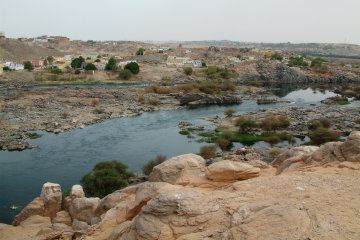
| |
| The First Cataract of the Nile as seen from the summit of Sahel Island. |
Aswan was the the southern-most town in Egypt and was located at the foot of the First Cataract of the Nile. This was where you left your comfortable boat and headed onwards on foot or camel-back. It was also where you left behind Egyptian civilisation and entered the uncivilised territory of the Nubians or Cushites. The Egyptians regarded the area - not without reason - as lawless and dangerous. From this point on the Nile flows between steep banks with only a few yards of flat land at the bottom (and often not even that) where crops might be grown.
The result was that merchants or ambassadors heading south felt it expedient to leave a prayer to the gods, begging for a safe trip. Rather fewer left monuments giving thanks for a safe return. Whether that is because not many did return safely or because they returned but had suffered some calamity along the way that ameliorated their gratitude, or whether it is just the natural human tendency to forget the vows and promises made to god in your time of need, I cannot say!
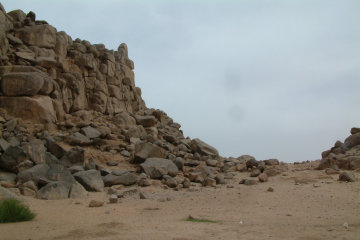
| |
| The scramble up to Hungry Rock gets easier round the back of this outcrop. |
To reach the Famine Stele you have to climb to the top of the granite hill - a bit of a scramble but not at all challenging for anyone with reasonable mobility - and then roam around until you find the rock. It was first identified in 1889 by the American journalist turned Egyptologist, Charles Edwin Wilbour, who also translated it.
The inscription is a bit of a puzzle. It describes events which - so it claims - took place during the reign of Pharaoh Djoser of the Third Dynasty. Djoser is best known to us for his burial place at Saqqara, the Step Pyramid which was created by his vizier, physician and architect, Imhotep. Allegedly in his 18th year the land of Egypt had been suffering from a famine which had continued for seven years. Djoser decides that he needs to find out where Hapi, the god of the Nile, was born and then propitiate either Hapi himself or the god who presides over the birthplace.
Imhotep volunteers to find out and discovers that Hapi was born at Yeb - Aswan - where the creator god Khnum is in charge. Imhotep travels down to the temple of Khnum and sleeps in the temple, thus giving the god a chance to speak to him. Khnum duly appears in a dream and promises to "make Hapi gush for you". Filled with gratitude, Imhotep promptly confers a huge tract of land on the god, exempts him and his temple from various taxes and grants him the right to a tenth of the value of any stones, including precious stones, produced in the deserts around Yeb and any trade that passes through it.
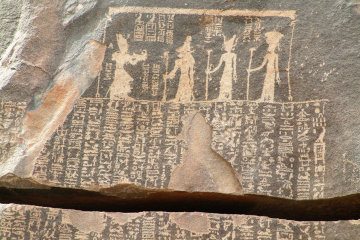
| |
| Detail of Hungry Rock and the inscription, which spans the prominent crack. |
The puzzle is that while some of the language in the inscription is suitably ancient, the style of the writing - the actual hieroglyphs themselves - is distinctly Ptolemaic. The Ptolemys ruled from 332 BC to 31 BC, whereas Djoser lived around 2680 BC. The question is, therefore, whether the events described in the Stele actually happened, or whether the Stele is a pious fraud erected in Ptolemaic times by the priests of Khnum in an attempt to bolster their income and their power!
According to the Stele inscription, the Stele was to be set up in the temple of Khnum, which was on Elephantine Island. However no such inscription has been found in the temple and Hungry Rock is clearly in its original position and has never been moved. The inscription is too long and the work of pecking it into the patina too arduous for this to be a schoolboy's writing exercise, nor is it likely that some budding author would write it down in this fashion or this location, as the equivalent of publishing one's first novel.
I think that the clue comes from the stone itself, for Hungry Rock is split in two horizontally, which most casual visitors think is the result of weathering since the inscription was made. However a careful study of the writing leads to the conclusion that the split was already there when the inscription was written!
The priests of Khnum couldn't suddenly produce a stele in the temple courtyard and claim that they had a hereditary right to vast territories. People would notice that the stele hadn't been there before and the suspicious Greek authorities would rapidly find the workmen who had created it and dragged it into position. However the priests could peck away at stones on the remote island of Sahel without attracting any attention and then pretend that they had only just discovered this ancient monumnet - and the split in the rock would give verisimilitude to their claim that it was an ancient grant of privileges and authority which should be restored to them.
Wilbour, when he first discovered and translated the inscription, believed that it was confirmation of the Biblical story of Joseph, recorded in Genesis 41. Unfortunately Djoser is about a thousand years too early for Joseph and even the Revised Chronology advocated by this website cannot bring him anywhere near the time of the Biblical story.
Extreme sceptics assert that the whole Joseph story is made up. They point out that the Book of the Temple describes a seven-year famine in the time of the Second Dynasty pharaoh Neferkasokar, that the Epic of Gilgamesh refers to a seven-year famine, as does another Mesopotamian legend. They claim, therefore, that a seven year famine was "a common motif" in "nearly all cultures of the Near East". A total of four references - two from Egypt and two from Mesopotamia - spread over nearly 3,000 years, hardly justifies either the "common motif" or the "nearly all cultures" claims! (I refer you back to what I said in my first paragraph!)
Throughout history Egypt has, from time to time, suffered from famines caused by the failure of the Nile to flood. A two-year famine is recorded for AD 967-9 while another two-year famine in 1201 is recorded by an eye-witness, Abdel-Latif al-Baghdadi, who reports widespread cannibalism as the starving Egyptians looted tombs in search of anything they could eat and parents even ate their own children. Noblewomen offered themselves for sale as slaves but without finding any buyers.
A seven-year famine would be unusual and yet studies in places as far apart as Iceland, Italy and Tibet have produced evidence that global cooling caused drastic fluctuations in climate during the period 2200 BC to 1890 BC. Disastrous famines and floods alternated as the climate altered. A multi-year famine in Egypt, caused by the failure of rains over the Ethiopian highlands, is not at all impossible. Under the Revised Chronology, this period covers the time of Joseph - a happy conjunction of facts that offers further support to the Revised Chronology.
Even if the priests of Khnum made up the Famine Stele story wholesale, they clearly did not regard mention of a seven-year famine as unbelievable. They had too much at stake financially to risk making wild and impossible claims. Thus, whether or not there actually was a long famine during the reign of Pharaoh Djoser, it seems to me that the Famine Stele can be taken as valid evidence for multi-year famines in Egypt.
a safe trip The idea of leaving a permanent prayer somewhere where the god could see it and be constantly reminded, was typically Egyptian. Not far from Aswan you have the healing sanctuary of Kom Ombo and there are numerous graffiti of a pair of feet scratched into the floor. The idea was that even if you had to go home with your prayer for healing unanswered, you would still be virtually standing in the god's presence, continuing to remind him of your need for help. Return
© Kendall K. Down 2021





